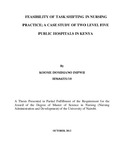| dc.description.abstract | Task shifting denotes a process of delegation whereby tasks are delegated, where appropriate to less specialized health workers who in most cases have lower qualifications and shorter training (WHO, 2008). According to WHO (2006) only six out of forty six countries meet health worker density of 2.5 Doctors, Nurses and Midwives per 1000 population required to achieve health outcomes.
Kenya has a health worker density of 1.98 per 1000 population (NCP AD, 2005).Nurses and midwives density stood at 0.4111000 population by 2010(WHO, 2010). To help bridge this gap of health worker density population ratio, countries have been asked to embrace task shifting. This study was therefore designed to explore task shifting knowledge, attitude and practices among nurses at two level five public hospitals in Kenya.
Materials and methods
A cross sectional survey was conducted in two level Spublic hospitals in a period of two months from 23rd April, 2012 to ISthJune, 2012. Stratified random sampling method was used to select the respondents for the study
A structured self administered questionnaire developed by the investigator was used to gather data on socio-demographics, task shifting knowledge, attitudes, practices and barriers from nurse practitioners. Part two of the study explored attitudes towards task shifting among nurse supervisors, nurse representatives and regulators of nursing through key informant interviews. An indepth guide was used to guide the interviews.
Data cleaning and entry was done using EPI info. Quantitative data analysis was done using Statistical Package for Social Sciences (SPSS) version 17.0. Chi square and Fishers exact tests were used to test relationships at 0.05significance level. Qualitative data was transcribed and analyzed using Nvivo version 9.0.
Results
The results showed that majority of the nurses (70%, n=162) understood the concept of task shifting. Majority of the nurses (70%) supported task shifting. Support increased with increase in years of practice (p=0.02S). There was also a strong correlation between knowledge and support for task shifting (p=<O.OOl). There was no significant association between facility and support for task shifting (p=O.3).
Results further show that support staff performed most of the shifted task (73.4%, n=118) and that there was a positive correlation between perceived benefits and self report task shifting practice (p=O.Ol)
There was a positive correlation between facility and preferred task for shifting with nurses in Nyeri PGH more likely to delegate collection of drugs and other supplies compared to those in Embu PGH(p=O.004) Asked about what conditions are required for effective task shifting 68% (n=157) mentioned regular support supervision, while 65% mentioned training (n=151). Finally, Insufficient number of trained personnel to which tasks can be shifted was considered the greatest obstacle to task shifting by 78.9% (n=165) of the respondents.
Conclusion and Recommendations
Nurses have adequate knowledge, are supportive of task shifting and task shifting is rife in nursing practice with support staffs performing most of the shifted tasks. Nurses considered supportive supervision and training as a prerequisite to effective task shifting. As a way forward, stakeholders including the Nursing council, NNAK and MOH need to explore task shifting as a strategy for improving the quality of patient care. | en_US |

